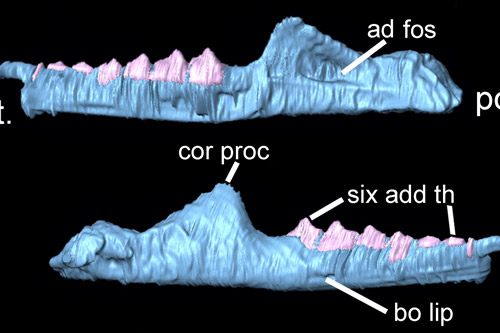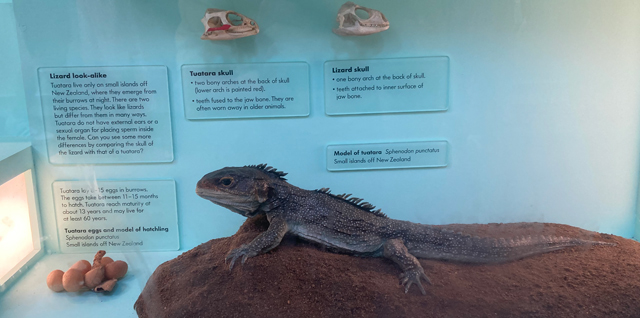Fossil from South Wales Identified as New Triassic Species
In the 1950s the Pant-y-ffynnon Quarry in South Glamorgan (Wales), provided a wide variety of vertebrate fossils giving palaeontologists an insight into the fauna of an ancient Triassic archipelago. However, a comprehensive analysis of the fossil material was not carried out. Scientists from the University of Bristol including an undergraduate student have undertaken a systematic review of the specimens and this has resulted in the naming of a new species of Rhynchocephalian. The little reptile has been named Clevosaurus cambrica and this newly described animal hints at adaptive radiation for the clevosaurs on the island chain. In addition, since the researchers found no evidence of any reptiles in excess of two metres, they propose that the palaeofauna represents a possible example of insular dwarfism.
The concept of insular dwarfism (sometimes referred to as the “island rule” involves residents of islands with limited resources tending to become smaller overtime when compared to their mainland counterparts.
A Three-Dimensional Computer-generated Image of the Jawbone of C. cambrica
Picture credit: Bristol University
Clevosaurus cambrica – “Gloucester Lizard from Wales”
Emily Keeble’s final-year project for a degree in palaeontology at the School of Earth Sciences, (Bristol University) involved a reappraisal of the Pant-y-ffynnon Quarry specimens. Working alongside her course supervisors, the undergraduate was able to identify a new species of Clevosaurus, a type of reptile that was widespread across the supercontinent Pangaea in the Late Triassic. Clevosaurus was named after “Clevum”, the Latin name for the city of Gloucester, as a number of species have been identified from this locality. The trivial name “cambrica” honours Wales, where the fossil quarry is located.
In the Late Triassic, the hills of South Wales and the south-western part of England formed an archipelago that was inhabited by early dinosaurs, crocodylomorphs distantly related to modern crocodiles and alligators along with representatives of the Sphenodontidae such as the clevosaurs. The once diverse and geographically reptile family – the Sphenodontidae is today, represented by the rare Tuatara (Sphenodon punctatus) which is limited to a few small islands off New Zealand.
Clevosaurus cambrica Would Have Looked Like a Tuatara
Picture credit: Everything Dinosaur
Commenting on the significance of her discovery, Emily said:
“The new species, Clevosaurus cambrica lived side-by-side with a small dinosaur, Pantydraco, and an early crocodile-like animal, Terrestrisuchus. We compared it with other examples of Clevosaurus from locations around Bristol and South Gloucestershire, but our new beast is quite different in the arrangement of its teeth.”
Clevosaurus cambrica has been identified based on some articulated bones and some isolated fragments. An analysis of the teeth in the jaws provided evidence that this small reptile probably was an insectivore. The shape of the teeth and their arrangement identified the fossil as a new species.
Professor Mike Benton, a co-author of the paper and one of Emily’s supervisors added:
“We were lucky to find quite a lot of the skeleton and Emily was able to scan the blocks and make 3-D reconstructions of the skull, neck, shoulder and arm region.”
Evidence of Insular Dwarfism
The researchers conclude that the archipelago held a relatively impoverished fauna, dominated by rhynchocephalians such as the clevosaurs. The new species has a dental morphology that is intermediate between the Late Triassic Clevosaurus hudsoni, from Cromhall Quarry to the east, and the younger C. convallis from Pant Quarry to the west, suggesting adaptive radiation of clevosaurs in the palaeo-archipelago. Adaptive radiation is the term used to describe the evolutionary process whereby organisms diverge from a common ancestor to fill a multitude of different ecological niches, think of Darwin’s finches on the Galapagos Islands, for example.
Co-author of the paper and co-supervisor of Emily Dr Whiteside (Bristol University) explained:
“The dinosaurs, crocodiles, and lizards were isolated to some extent on their islands, and perhaps smaller ones were better at surviving in the changed ecologies of the islands.”
The scientific paper: “The terrestrial fauna of the Late Triassic Pant-y-ffynnon Quarry fissures, South Wales, UK and a new species of Clevosaurus (Lepidosauria: Rhynchocephalia)” by Keeble et al published in the Proceedings of the Geologists’ Association.
Everything Dinosaur acknowledges the help of a press release from Bristol University in the compilation of this article.
Visit the Everything Dinosaur website: Everything Dinosaur.








Leave A Comment